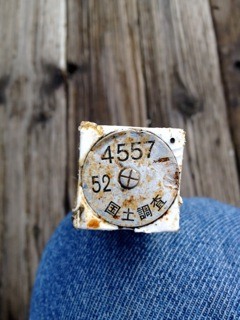When Tom Averna looked down into the water next to his boat, he saw an object that looked out of place. He fished it out, and was surprised to find what appeared to be a survey stake with Asian characters on it – a possible remnant from the tsunami that ravaged Japan last year.
“Just goes to show the power of the ocean currents,” said Averna, owner of Deer Harbor Charters.
And it’s not just small items that are floating toward Pacific Northwest shores. A rusty 164-foot Japanese fishing ship was spotted adrift off the Coast of British Columbia’s Queen Charlotte Islands in late March.
The vessel is one of several being tracked by authorities after the March 2011 quake, which registered magnitude 9.0, and tsunami. Together, the events killed more that 15,000 people in northeast Japan.
The National Oceanic and Atmospheric Administration and its partners have identified three vessels, including the one in Canada, which were likely set adrift because of the tsunami.
But the origins of smaller objects, like the survey stake, are harder to track.
“It is difficult to confirm whether or not marine debris, even with foreign writing, is from the tsunami,” said Keeley Belva of NOAA. “Marine debris is a common problem for our ocean and seashores everyday, especially around the Pacific.”
The Japanese government estimated that the tsunami swept about 5 million tons of debris into the ocean, but that 70 percent sank off shore, leaving 1.5 million tons floating. There is no estimate of how much debris is still floating today.
It’s highly unlikely the debris is radioactive – most of it was miles away from the damaged reactor, and the leak of contaminated water from the reactor into the sea started days to weeks after the debris was washed out to sea, according to NOAA.
U.S. Sen. Maria Cantwell recently issued a statement saying that with flotsam reaching the West Coast sooner than expected, the U.S. can’t afford to cut funds from NOAA’s marine debris program.
Belva said the program is working with federal, state and local partners to collect data, assess the debris, and reduce possible impacts to natural resources and coastal communities.
NOAA originally predicted items from the tsunami would begin washing up on shores in the Pacific Northwest in 2013. Those were rough estimates based on forecasted ocean conditions and reports of debris from fishing and commercial vessels. NOAA researchers are currently relying on computer models to predict the debris’ path and drift rate.
The bulk of debris is still believed to be north of the main Hawaiian Islands and east of the Midway Atoll.
NOAA predicts that pieces of wood, plastic and other remnants from the tsunami will show up on Pacific beaches for decades to come.
“If people find debris that can easily and safely be disposed of, we ask that they do so,” Belva said. “However if it’s personal items or something that looks like it can be returned to an owner, or other significant debris, the sighting can be reported to NOAA.”
As for the 164-foot “ghost ship,” a U.S. Coast Guard cutter unleashed cannon fire on the vessel Thursday. It sank into waters more than 6,000 feet deep in the Gulf of Alaska.
People cleaning up shorelines are urged to be careful of sharp objects that could cut your hands; avoid picking up sealed containers of chemicals – they may crack or break and spill the content on you. Likewise, report any full drum on the beach, and avoid handling it.
For Averna, finding this remnant of such a disaster on Orcas gave him an eerie feeling that flotsam has survived when so many people have not.
“I thought that whoever put that stake in the ground might be gone,” said Averna. “Finding this really gave it more of a reality for me.”
Report debris to DisasterDebris@noaa.gov.
To see photos of the “ghost ship,” visit http://peninsuladailynews.com/article/20120406/NEWS/304069984#.



